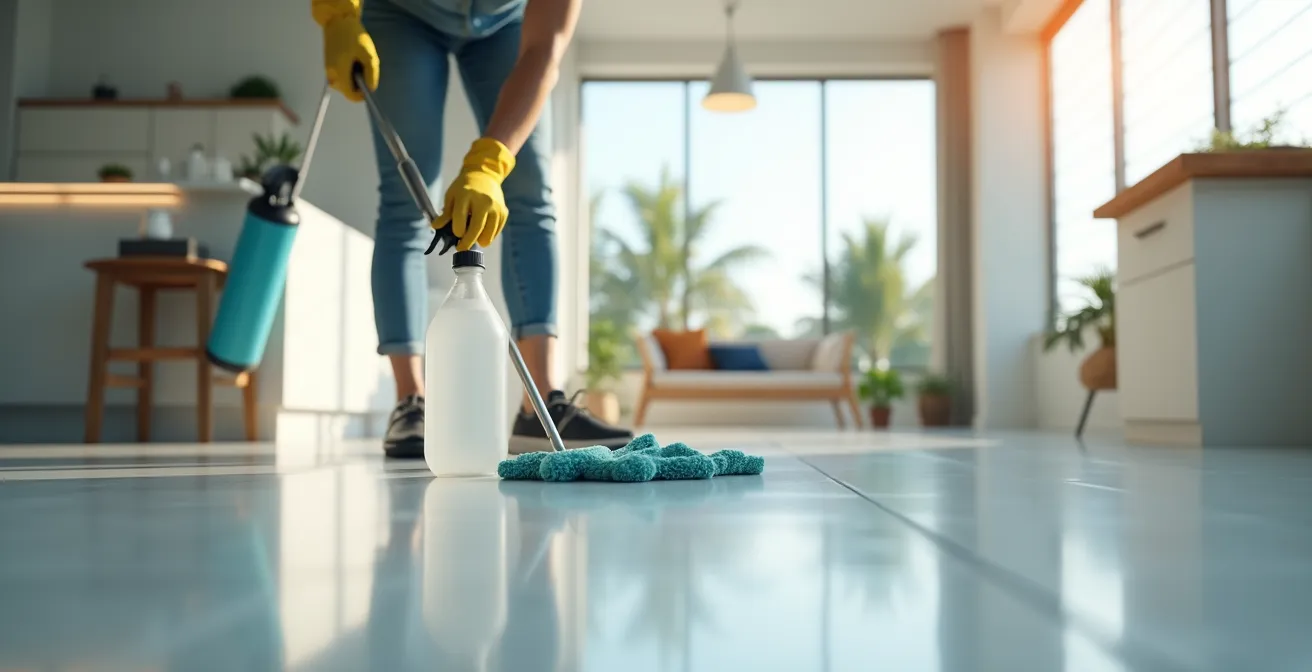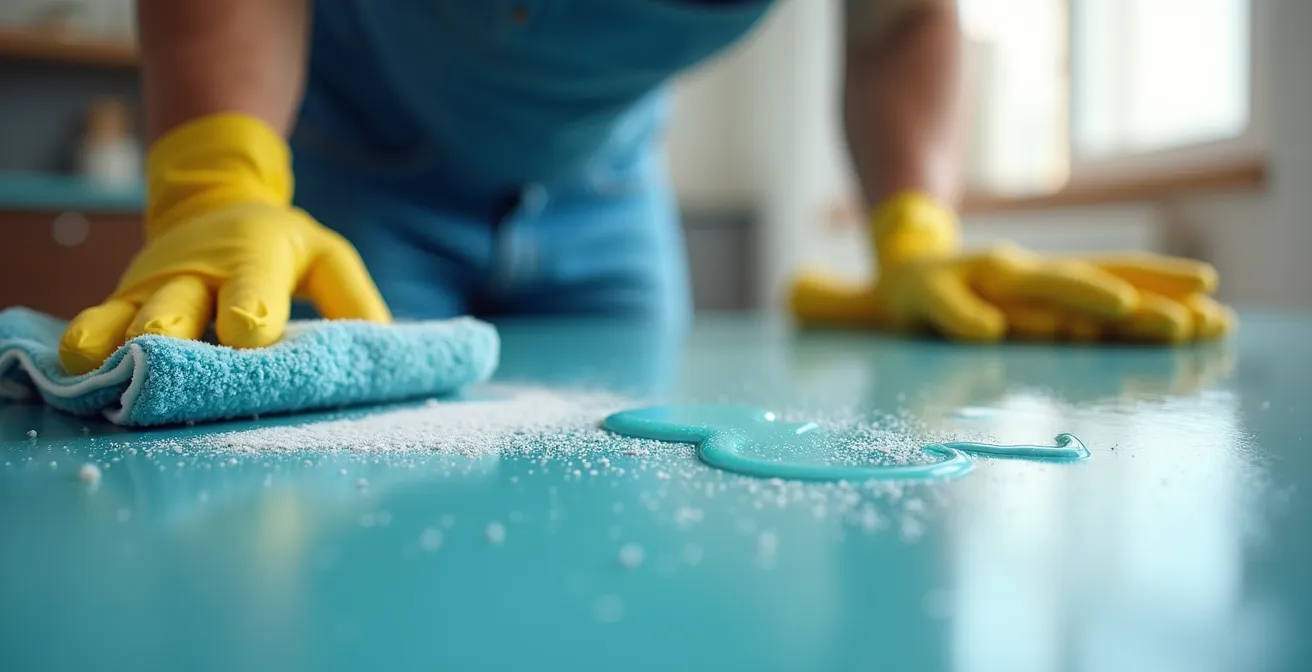
The final nail has been hammered, the last coat of paint has dried, and your renovation project is officially complete. Yet, a fine layer of dust covers every surface, and the air still carries the scent of construction. This is the critical moment where the transition from a worksite to a home truly begins. Many underestimate this final step, viewing it as a simple cleanup, but it’s a specialized process that safeguards your investment and health. To truly finalize your project, a specialized post-renovation cleaning service is essential.
Professional post-renovation cleaning is not merely about aesthetics; it is a technical necessity focused on material preservation and creating a healthy indoor environment. It addresses the hidden residues and microscopic dust that can damage new finishes and compromise air quality long after the contractors have left. This is about protecting the thousands you’ve invested in new materials and ensuring your space is safe from the outset.
The Blueprint for a Flawless Finish
A professional service moves beyond surface wiping to tackle microscopic dust, stubborn construction residues, and hidden contaminants. This crucial final step protects the longevity of your new materials, ensures healthy indoor air quality, and prepares your space for immediate, safe occupancy, safeguarding your overall renovation investment.
Navigating Stubborn Residues: Advanced Techniques for Post-Renovation Cleaning Challenges
Once the primary debris is cleared, the real challenge begins: tackling the stubborn, often invisible, residues left behind. Without professional intervention, there’s an estimated 85% of stubborn dust remaining after renovation, which can damage surfaces and degrade air quality. These remnants require more than just standard cleaning methods; they demand specialized knowledge and tools.
One of the most common issues is paint splatter and overspray on new fixtures, floors, and windows. Another is the sticky residue from protective films and labels, which can seem impossible to remove without scratching delicate surfaces. Professionals also focus on grout haze on new tilework and the pervasive fine dust that settles deep within air vents, carpets, and crevices, which can circulate for months if not properly extracted.
Effective removal of paint splatters requires careful selection of solvents to avoid surface damage, especially on delicate finishes.
– Jane Smith, Total Home Service Cleaning Guide
The right tools and techniques are paramount for addressing these challenges. A professional team utilizes a combination of specialized solvents, steam cleaners, and non-abrasive tools to lift adhesives and paint without compromising the integrity of the surface beneath.

This meticulous work ensures that every new element of your renovation is presented flawlessly. For instance, HEPA-filter vacuums are essential for capturing the finest particulate matter, preventing it from becoming an ongoing respiratory irritant. It is this attention to microscopic detail that differentiates a professional clean from a basic wipe-down.
Effective Adhesive Removal on Renovated Windows
A case study illustrating the use of gentle solvents and steam cleaning techniques to remove stubborn adhesive residues from newly installed window fixtures without causing any damage.
Beyond Surface Shine: How Professional Cleaning Preserves Your New Finishes
The true value of a professional post-construction clean lies in its protective function. Lingering construction dust is not inert; it is often abrasive and can contain chemical residues from building materials. If left unattended, this grit can cause microscopic scratches on new hardwood floors, dull high-gloss finishes, and even etch natural stone surfaces over time.
Without proper removal, these residues can lead to a potential 40% reduction in lifespan for materials, causing premature wear and tear. A professional service understands the specific care requirements for different materials, applying protocols that preserve their integrity and appearance from day one. This proactive care is an investment in the longevity of your renovation.
How does post-renovation cleaning protect new surfaces?
It uses specialized, non-abrasive techniques and pH-neutral cleaners to remove corrosive dust and chemical residues, preventing scratches, stains, and premature wear on materials like hardwood and natural stone.
Furthermore, a professional clean is critical for ensuring a healthy indoor environment. Construction activities release a host of volatile organic compounds (VOCs) and fine particulates into the air. These unseen contaminants can trigger allergies, asthma, and other respiratory issues. A thorough cleaning, including air filtration and vent sanitation, eliminates these threats, ensuring the air in your newly renovated home is safe to breathe from the moment you move in.
Professional post-renovation cleaning protocols significantly prevent premature wear on delicate surfaces such as natural stone or hardwood.
– Michael Turner, Clean My Space Insights
To ensure materials are properly cared for, specific cleaning methods are essential. The following list outlines key protocols used by experts to protect high-end finishes during the post-renovation phase.
Protocols to Protect Delicate Finishes
- Use pH-neutral cleaners for natural stone and hardwood.
- Avoid abrasive tools and harsh chemicals on high-gloss finishes.
- Apply sealants and protective coatings where recommended.
- Use microfiber cloths for wiping to prevent scratches.
Preservation of Hardwood Floors After Renovation
Demonstrated how targeted cleaning techniques and use of protective coatings extended hardwood floor life by preventing moisture damage and surface scratches.
The Strategic Timing of Your Post-Renovation Clean
Timing is a crucial, yet often overlooked, component of an effective post-renovation cleanup. The process is not a single event but a strategically phased approach that aligns with the construction timeline. An initial “rough clean” is often performed after major systems are installed but before final finishes like flooring and painting are complete. This removes bulk debris and protects the work of finishing trades from being damaged by grit and dust.
The “final detail clean” is the most intensive phase and should be scheduled once all contractors have completely vacated the premises. The ideal window for this is ideally within 48-72 hours after all construction work is finished. This timing prevents new dust from settling while ensuring all curing times for paint, sealants, and adhesives have passed, making the surfaces ready for a deep clean. Coordinating this schedule is key to an efficient project handover and avoiding rework.
This multi-phase strategy ensures that each stage of the renovation is protected, culminating in a flawless finish. The table below breaks down the different cleaning phases and their ideal placement within the project timeline.
| Cleaning Phase | Description | Ideal Timing |
|---|---|---|
| Rough Clean | Remove large debris and dust | Before finishing trades |
| Final Detail Clean | Deep cleaning for move-in | 48-72 hours post renovation |
| Touch-Up Clean | Address last-minute spots | Just before occupancy |
Effective coordination with your contractors is vital to the success of the cleaning schedule. Open communication prevents delays and ensures that the cleaning crew has full, unimpeded access to the site at the optimal time. An expert in professional cleaning after construction will know how to integrate their work seamlessly into the final stages of your project.
Steps to Coordinate Cleaning with Contractors
- Communicate cleaning schedule early with all contractors.
- Plan cleaning phases around key renovation tasks.
- Allow buffer time to avoid delays.
- Confirm completion of contractors’ work before final clean.
Key Takeaways
- Professional cleaning is a technical process that protects material longevity and indoor air quality.
- Specialized techniques are required to remove stubborn residues like paint, adhesives, and fine dust.
- The timing of the clean is crucial and should be strategically phased with the construction timeline.
- Choosing the right crew involves vetting their experience with specific materials and specialized equipment.
What ‘Professionally Clean’ Truly Means: Selecting the Right Post-Construction Crew
Not all cleaning services are equipped to handle the unique demands of a post-construction site. A true professional service goes far beyond a standard checklist. They possess the specialized equipment—like industrial-grade HEPA vacuums and air scrubbers—and eco-friendly, material-specific cleaning solutions necessary to do the job safely and effectively. A reputable crew will be capable of removing up to 95% of all construction residue, ensuring a truly move-in-ready space.
When selecting a company, it’s crucial to ask about their experience with the specific materials used in your renovation. As industry analyst David Lopez notes, choosing a company with the right tools and solutions is vital for an efficient, damage-free outcome. A key indicator of a high-quality service is their insistence on a site-specific assessment to provide a detailed, customized proposal. This demonstrates their commitment to understanding the unique challenges of your project.
Customized Cleaning Proposal Leads to Seamless Handover
A professional cleaning crew conducted site-specific assessments to tailor a detailed cleaning proposal, ensuring the property was immaculate and ready for final inspection without delay.
Ultimately, a professional cleaning service plays a direct role in the success of the final project inspection and handover. Their meticulous work ensures the property is presented in its best possible light. To make the right choice, use the following questions as a guide when vetting potential companies. When you are ready, you can Find renovation professionals who meet these standards.
Key Questions to Vet Post-Construction Cleaning Services
- What experience do you have with specific materials and residues?
- Do you use eco-friendly and specialized equipment?
- Can you provide references and case studies?
- Do you offer site assessments and customized proposals?
Frequently Asked Questions on Post-Renovation Cleanup
Can I do post-renovation cleaning myself?
While possible for very small projects, DIY cleaning is often not recommended. Professionals have specialized equipment like HEPA vacuums to capture fine dust, and the right solvents to remove construction residues without damaging new surfaces. It is also physically demanding and time-consuming.
How long does a professional post-construction clean take?
The duration depends on the size of the property and the scope of the renovation. A smaller renovation may take a single day, while a larger, newly constructed home could take several days to clean thoroughly.
Is post-renovation cleaning more expensive than regular cleaning?
Yes, it is typically more expensive due to its intensive nature. It requires specialized tools, stronger cleaning agents, more labor, and the removal of difficult residues like paint, grout haze, and fine particulate dust that standard cleaning does not address.
What’s the difference between a rough clean and a final clean?
A rough clean is a preliminary phase that removes large debris, dust, and trash before final installations like flooring. A final detail clean is a meticulous, top-to-bottom cleaning performed after all construction is complete to make the space move-in ready.